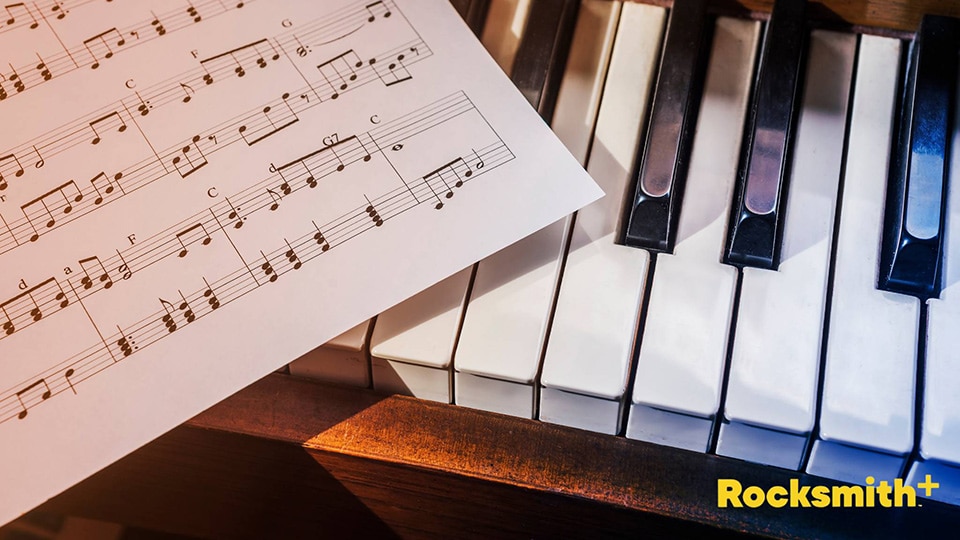The enchanting allure of the piano has captivated audiences for centuries. Whether it's the emotional depth of a melancholic piece or the spirited energy of an upbeat tune, the piano possesses an unmatched versatility.
However, behind its beauty lies a language --- a unique system of symbols and notations that allows musicians to translate emotions into sound.
This article breaks down how to read piano sheet music into an easily digestible, step-by-step format. And for those of you beginning your musical journey, Rocksmith+, with its song library of over 300 piano tracks and over 7,000 tracks for other instruments like guitar and bass, stands ready to be your trusted companion.
Let's dive into the piano beginner's guide.
1. The Basics of Music Notation
Music notation serves as a universal language for musicians around the globe. It's a structured system that captures the essence of melodies, harmonies, rhythms, and dynamics, enabling composers to pen down their creations and performers to interpret them accurately.
At its core, music notation revolves around specific symbols called music notes. These notes, part of the broader musical alphabet, are the building blocks of every tune you've ever cherished.
Understanding them is akin to learning the alphabet before diving into literature. The foundation of every song rests upon these notations.
2. The Piano Keyboard: White Keys and Black Keys
![[RS+] How To Read Piano Notes: Simplified Guide SEO ARTICLE - white keys and black keys](http://staticctf.ubisoft.com/J3yJr34U2pZ2Ieem48Dwy9uqj5PNUQTn/6jHnAwIZzbo5ACpbtCnrGG/7569d627da8adeb0fd5950666280babd/notes2.jpeg)
For your first time, take a moment to observe a piano, whether physically or in your mind's eye. The expanse of piano keys stretches out like an open canvas, waiting for an artist's touch. This layout consists of a repeating pattern of white and black keys.
The white keys represent the natural notes of the musical alphabet, while the black keys denote sharps and flats. Between any two white keys, you might find a black key, signifying a half-step increment. Recognizing this pattern is pivotal for anyone looking to learn piano, as it acts as a roadmap for the melodies and harmonies that await.
3. Understanding the Music Staff
As we delve deeper into the realm of music notation, the music staff emerges as our guiding beacon. Picture five parallel lines and the spaces in between --- that's your music staff. Each line and space corresponds to a particular note, depending on the clef symbol that begins the staff.
![[RS+] How To Read Piano Notes: Simplified Guide SEO ARTICLE - music staff](http://staticctf.ubisoft.com/J3yJr34U2pZ2Ieem48Dwy9uqj5PNUQTn/61vwwijq04Jn0ZMyNVOKlP/fdc73fce036522c5d01b9e99d7ee154e/unnamed__6_.jpg)
Imagine a grand highway with two lanes; the top lane represents the treble clef (or G clef), and the bottom lane represents the bass clef (or F clef). These clefs help determine which note each line or space means, providing a structured framework for melodies and harmonies.
4. Deciphering Treble Clef and Bass Clef
Let's journey into these two essential realms of the grand staff: the treble and bass clefs. The treble clef, resembling an ornate "G," is often associated with the right hand on the piano. From bottom to top, its lines are represented by the mnemonic "Every Good Bird Does Fly" (EGBDF), making it simpler for budding pianists to remember.
On the flip side, the bass clef, which looks a bit like a backward "C," pertains to the left hand. Its lines can be easily remembered using the phrase "All Cows Eat Grass." By familiarizing yourself with these mnemonics and the positions they represent on the piano keyboard, you'll find that reading sheet music becomes second nature.
5. The Middle C and Its Importance
If the piano were a city, Middle C would be its central landmark. This note is positioned centrally on the piano keyboard and bridges the treble and bass clefs. On sheet music, the Middle C can be found on a ledger line above the bass clef or just below the treble clef, making it a pivotal reference point for pianists.
As you venture through Rocksmith+'s diverse song library or any other piece of music, recognizing the Middle C will provide you with a sense of direction and context, ensuring you remain on the right musical path.
6. Music Theory: Scales and Intervals
Beyond the immediate world of sheet music lies the vast realm of music theory. One could think of it as the grammar that governs the language of music. In this universe, scales and intervals become crucial.
A scale is a sequence of notes that sets a piece's tonal foundation. The most familiar one, the Major scale, has a pattern of whole steps and half steps. These scales serve as pathways, guiding your fingers across the white and black keys of the piano keyboard.
Intervals, on the other hand, refer to the distance between two notes. Recognizing intervals can significantly enhance your sight-reading capabilities, allowing you to easily anticipate note jumps and navigate complex pieces. As you delve into Rocksmith+'s song library, understanding scales and intervals will undoubtedly elevate your playing experience.
7. Sight Reading and Practice
Knowing theory is one thing, but applying it is another. Sight reading is the skill of playing a piece of music you've never seen before, and it's one of the most valuable assets a pianist can develop.
Here's a step-by-step approach to effective sight reading:
- Scan the Piece: Before diving in, glance over the entire piece. Identify key and time signatures, note patterns, and potential challenges.
- Start Slowly: Pace is paramount. It's always better to play slowly and accurately than to rush and make mistakes.
- Use Mnemonics: Remember those handy phrases like "Every Good Bird Does Fly"? They're your sight-reading allies. Use them to navigate the staves.
- Practice Regularly: Like any other skill, sight reading improves with consistent practice. Dedicating even a few minutes daily can lead to substantial progress over time.
Moreover, platforms like Rocksmith+ offer a plethora of songs that can be used to hone this skill, catering to both beginners and seasoned pianists.
8. Navigating Common Musical Symbols and Notations
![[RS+] How To Read Piano Notes: Simplified Guide SEO ARTICLE - common musical symbols and notations](http://staticctf.ubisoft.com/J3yJr34U2pZ2Ieem48Dwy9uqj5PNUQTn/1ciEosvYWBapyLeEhzrm5N/43578152e8d3ffeaa604e807a84c7199/notes4.jpeg)
Sheet music isn't just about notes and clefs. It's dotted with symbols that guide the pianist in interpreting and performing the piece.
Some of these essential symbols include:
-
Bar Lines: Vertical lines that divide the music staff into measures.
![[RS+] How To Read Piano Notes: Simplified Guide SEO ARTICLE - bar lines](//staticctf.ubisoft.com/J3yJr34U2pZ2Ieem48Dwy9uqj5PNUQTn/2Kk1uRhlBIyFi9j1LEz7Jt/e1bc065d3bbd2c94e5006e774cf2e92e/bar_lines.png)
-
Ties: Curved lines that connect notes of the same pitch, indicating they should be played as a single, sustained note.
![[RS+] How To Read Piano Notes: Simplified Guide SEO ARTICLE - ties](//staticctf.ubisoft.com/J3yJr34U2pZ2Ieem48Dwy9uqj5PNUQTn/4w92vCEhR9YR8xnygeP6Km/aa4acac4d1c8a379e13df4fe55921c4b/ties.jpg)
-
Repeat Signs: Denote a section of music that should be played again.
![[RS+] How To Read Piano Notes: Simplified Guide SEO ARTICLE - repeat signs](//staticctf.ubisoft.com/J3yJr34U2pZ2Ieem48Dwy9uqj5PNUQTn/1ZUAPXgcjlfSEqlE1ViTha/7434c984b5c3f1d82bc913cb725d4dd7/repear.png)
-
Dynamics: Symbols (like p for soft and f for loud) that indicate the volume at which a section should be played.
![[RS+] How To Read Piano Notes: Simplified Guide SEO ARTICLE - dynamics](//staticctf.ubisoft.com/J3yJr34U2pZ2Ieem48Dwy9uqj5PNUQTn/1eFoKpwfwO4IZnSjLPdpAF/c8f073a0055af1a5534ff82c22c4f426/dynamics.jpg)
These symbols, combined with the knowledge of note names and values, provide a comprehensive guide, ensuring you play every piece, be it a classic or one from Rocksmith+'s expansive library, as the composer intended.
9. Demystifying Note Lengths
One of the foundational aspects of music is rhythm, and understanding note lengths is crucial in mastering it. Different symbols indicate how long each note or rest should be held relative to the beat of the music.
Let's break them down:
-
Whole Note: Represented by an open oval, a whole note is held for four beats. It's the longest common note length in most pieces.
![[RS+] How To Read Piano Notes: Simplified Guide SEO ARTICLE - whole note](//staticctf.ubisoft.com/J3yJr34U2pZ2Ieem48Dwy9uqj5PNUQTn/3EVi3ooazyOSvJZg6BGHzt/0062cdb1eb3329db2b32e720952ab3a6/whole-note.jpg)
-
Half Note: Half the length of a whole note, this note is played for two beats. It's depicted as an open oval with a stem.
![[RS+] How To Read Piano Notes: Simplified Guide SEO ARTICLE - half note](//staticctf.ubisoft.com/J3yJr34U2pZ2Ieem48Dwy9uqj5PNUQTn/3S4RDTYnY5MuDI448sviGH/a89839e74a4022de9f41b90a1362d808/half_note.jpg)
-
Quarter Note: This gets one beat. It's an essential rhythmic component and is illustrated as a filled oval with a stem.
![[RS+] How To Read Piano Notes: Simplified Guide SEO ARTICLE - quarter note](//staticctf.ubisoft.com/J3yJr34U2pZ2Ieem48Dwy9uqj5PNUQTn/7AyvMhNStnpSOY02IO0LyA/1c5285957e8d64bc45aad20674f67658/quarter.jpg)
-
Eighth Note: As the name suggests, it's half the duration of a quarter note, lasting for half a beat. These notes often appear in pairs, connected by a beam.
![[RS+] How To Read Piano Notes: Simplified Guide SEO ARTICLE - eighth note](//staticctf.ubisoft.com/J3yJr34U2pZ2Ieem48Dwy9uqj5PNUQTn/6kCkHUS4rk6ylf5HM9Eok3/638e5b49a79a0489385bd4681e25fae4/eight.jpg)
-
Other Notes: Sixteenth notes (1/4 beat), thirty-second notes (1/8 beat), and even sixty-fourth notes (1/16 beat) exist and are each half the length of the previous note. As the notes get shorter, more tails or beams are added to their stems.
![[RS+] How To Read Piano Notes: Simplified Guide SEO ARTICLE - other notes](//staticctf.ubisoft.com/J3yJr34U2pZ2Ieem48Dwy9uqj5PNUQTn/4TD3pWhzHMcmEdAgI5u7KA/259c7eae7a91cf40c70b3daa3948bfe1/other.png)
Comprehending these note lengths and their corresponding rests is pivotal for ensuring accurate rhythm. As you explore songs in Rocksmith+'s expansive library, understanding these will allow for a more authentic and rhythmically sound performance.
What Are Some Tips for Aspiring Pianists?
Ready to get playing? Here are some of our top tips for aspiring pianists looking to hone their skills:
- Consistent Practice: Like any craft, consistency is key. Regularly spending time at the keyboard, even for short durations, will yield results.
- Seek Feedback: Platforms like Rocksmith+ allow instant feedback, aiding the learning journey. However, it's also beneficial to play for friends or even consider occasional in-person piano lessons for personalized advice.
- Stay Curious: Explore various genres and pieces. Dive into Rocksmith+'s diverse song library, from classics to contemporary tunes, to challenge and inspire you.
- Stay Positive and Patient: Learning an instrument is a journey. Celebrate small victories, and remember that every pianist, from beginners to maestros, once started at the same point.
Every Note Is a Step Forward
Embarking on the journey of reading piano notes is like unlocking a new language. While it might appear complex at first glance, with patience and persistence, these symbols and terms gradually transform into beautiful melodies under your fingertips.
Platforms like Rocksmith+ are not just tools but partners in this journey, making learning accessible and engaging for everyone.
Whether you're just starting or revisiting the piano after some time away, remember that every session, note, and song brings you closer to piano mastery. Here's to your musical journey, filled with discoveries, growth, and endless melodies!
Sources:
Natural Sign in Music. Natural Notes on piano | Piano Keyboard Guide
Treble Clef and Bass Clef Guide: What Are Clefs in Music? | MasterClass
Where Is Middle C? (Various Instruments, Explained Simply) | Producer Hive
What are Music Scales? | Simplifying Theory
What Is A Measure In Music? ( 5 Types, Examples, Counting ) | Hip Hop Maker

![[RS+] How To Read Piano Notes: Simplified Guide SEO ARTICLE - bar lines](http://staticctf.ubisoft.com/J3yJr34U2pZ2Ieem48Dwy9uqj5PNUQTn/2Kk1uRhlBIyFi9j1LEz7Jt/e1bc065d3bbd2c94e5006e774cf2e92e/bar_lines.png)
![[RS+] How To Read Piano Notes: Simplified Guide SEO ARTICLE - ties](http://staticctf.ubisoft.com/J3yJr34U2pZ2Ieem48Dwy9uqj5PNUQTn/4w92vCEhR9YR8xnygeP6Km/aa4acac4d1c8a379e13df4fe55921c4b/ties.jpg)
![[RS+] How To Read Piano Notes: Simplified Guide SEO ARTICLE - repeat signs](http://staticctf.ubisoft.com/J3yJr34U2pZ2Ieem48Dwy9uqj5PNUQTn/1ZUAPXgcjlfSEqlE1ViTha/7434c984b5c3f1d82bc913cb725d4dd7/repear.png)
![[RS+] How To Read Piano Notes: Simplified Guide SEO ARTICLE - dynamics](http://staticctf.ubisoft.com/J3yJr34U2pZ2Ieem48Dwy9uqj5PNUQTn/1eFoKpwfwO4IZnSjLPdpAF/c8f073a0055af1a5534ff82c22c4f426/dynamics.jpg)
![[RS+] How To Read Piano Notes: Simplified Guide SEO ARTICLE - whole note](http://staticctf.ubisoft.com/J3yJr34U2pZ2Ieem48Dwy9uqj5PNUQTn/3EVi3ooazyOSvJZg6BGHzt/0062cdb1eb3329db2b32e720952ab3a6/whole-note.jpg)
![[RS+] How To Read Piano Notes: Simplified Guide SEO ARTICLE - half note](http://staticctf.ubisoft.com/J3yJr34U2pZ2Ieem48Dwy9uqj5PNUQTn/3S4RDTYnY5MuDI448sviGH/a89839e74a4022de9f41b90a1362d808/half_note.jpg)
![[RS+] How To Read Piano Notes: Simplified Guide SEO ARTICLE - quarter note](http://staticctf.ubisoft.com/J3yJr34U2pZ2Ieem48Dwy9uqj5PNUQTn/7AyvMhNStnpSOY02IO0LyA/1c5285957e8d64bc45aad20674f67658/quarter.jpg)
![[RS+] How To Read Piano Notes: Simplified Guide SEO ARTICLE - eighth note](http://staticctf.ubisoft.com/J3yJr34U2pZ2Ieem48Dwy9uqj5PNUQTn/6kCkHUS4rk6ylf5HM9Eok3/638e5b49a79a0489385bd4681e25fae4/eight.jpg)
![[RS+] How To Read Piano Notes: Simplified Guide SEO ARTICLE - other notes](http://staticctf.ubisoft.com/J3yJr34U2pZ2Ieem48Dwy9uqj5PNUQTn/4TD3pWhzHMcmEdAgI5u7KA/259c7eae7a91cf40c70b3daa3948bfe1/other.png)








